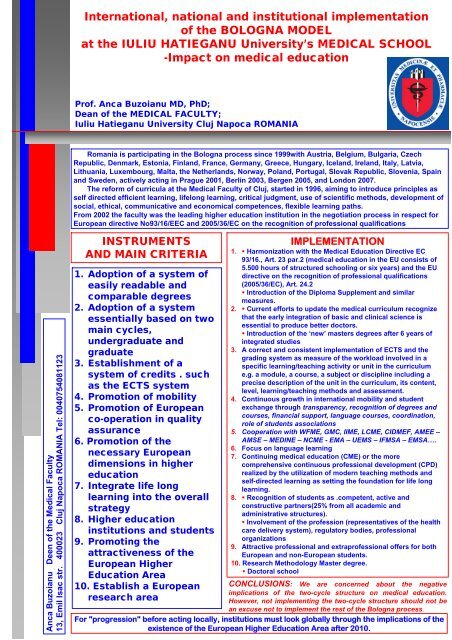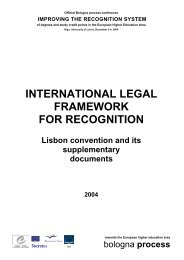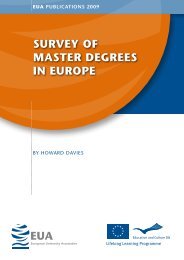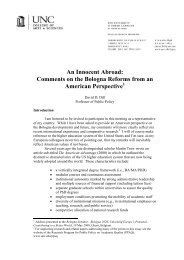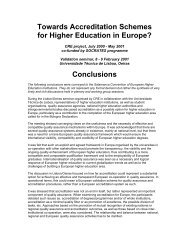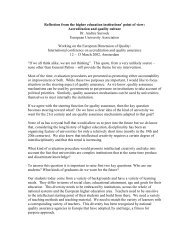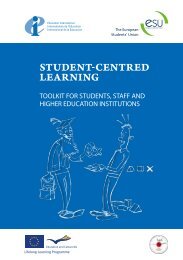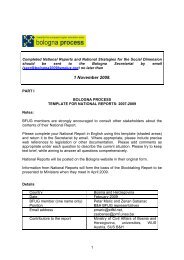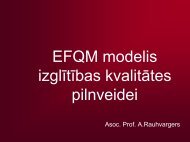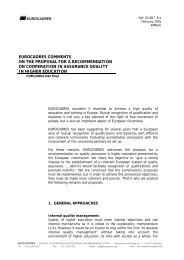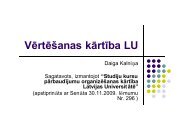BOLOGNA AND MEDICAL DEGREES – THE IMPORTANCE OF ...
BOLOGNA AND MEDICAL DEGREES – THE IMPORTANCE OF ...
BOLOGNA AND MEDICAL DEGREES – THE IMPORTANCE OF ...
You also want an ePaper? Increase the reach of your titles
YUMPU automatically turns print PDFs into web optimized ePapers that Google loves.
Anca Buzoianu Deen of the Medical Faculty<br />
13, Emil Isac str. 400023 Cluj Napoca ROMANIA Tel: 0040754081123<br />
International, national and institutional implementation<br />
of the <strong>BOLOGNA</strong> MODEL<br />
at the IULIU HATIEGANU University’s <strong>MEDICAL</strong> SCHOOL<br />
-Impact on medical education<br />
Prof. Anca Buzoianu MD, PhD;<br />
Dean of the <strong>MEDICAL</strong> FACULTY;<br />
Iuliu Hatieganu University Cluj Napoca ROMANIA<br />
Romania is participating in the Bologna process since 1999with Austria, Belgium, Bulgaria, Czech<br />
Republic, Denmark, Estonia, Finland, France, Germany, Greece, Hungary, Iceland, Ireland, Italy, Latvia,<br />
Lithuania, Luxembourg, Malta, the Netherlands, Norway, Poland, Portugal, Slovak Republic, Slovenia, Spain<br />
and Sweden, actively acting in Prague 2001, Berlin 2003, Bergen 2005, and London 2007.<br />
The reform of curricula at the Medical Faculty of Cluj, started in 1996, aiming to introduce principles as<br />
self directed efficient learning, lifelong learning, critical judgment, use of scientific methods, development of<br />
social, ethical, communicative and economical competences, flexible learning paths.<br />
From 2002 the faculty was the leading higher education institution in the negotiation process in respect for<br />
European directive No93/16/EEC and 2005/36/EC on the recognition of professional qualifications<br />
INSTRUMENTS<br />
<strong>AND</strong> MAIN CRITERIA<br />
1. Adoption of a system of<br />
easily readable and<br />
comparable degrees<br />
2. Adoption of a system<br />
essentially based on two<br />
main cycles,<br />
undergraduate and<br />
graduate<br />
3. Establishment of a<br />
system of credits . such<br />
as the ECTS system<br />
4. Promotion of mobility<br />
5. Promotion of European<br />
co-operation in quality<br />
assurance<br />
6. Promotion of the<br />
necessary European<br />
dimensions in higher<br />
education<br />
7. Integrate life long<br />
learning into the overall<br />
strategy<br />
8. Higher education<br />
institutions and students<br />
9. Promoting the<br />
attractiveness of the<br />
European Higher<br />
Education Area<br />
10. Establish a European<br />
research area<br />
IMPLEMENTATION<br />
1. � Harmonization with the Medical Education Directive EC<br />
93/16., Art. 23 par.2 (medical education in the EU consists of<br />
5.500 hours of structured schooling or six years) and the EU<br />
directive on the recognition of professional qualifications<br />
(2005/36/EC), Art. 24.2<br />
� Introduction of the Diploma Supplement and similar<br />
measures.<br />
2. � Current efforts to update the medical curriculum recognize<br />
that the early integration of basic and clinical science is<br />
essential to produce better doctors.<br />
� Introduction of the ‘new’ masters degrees after 6 years of<br />
integrated studies<br />
3. A correct and consistent implementation of ECTS and the<br />
grading system as measure of the workload involved in a<br />
specific learning/teaching activity or unit in the curriculum<br />
e.g. a module, a course, a subject or discipline including a<br />
precise description of the unit in the curriculum, its content,<br />
level, learning/teaching methods and assessment.<br />
4. Continuous growth in international mobility and student<br />
exchange through transparency, recognition of degrees and<br />
courses, financial support, language courses, coordination,<br />
role of students associations<br />
5. Cooperation with WFME, GMC, IIME, LCME, CIDMEF, AMEE –<br />
AMSE – MEDINE – NCME - EMA – UEMS – IFMSA – EMSA….<br />
6. Focus on language learning<br />
7. Continuing medical education (CME) or the more<br />
comprehensive continuous professional development (CPD)<br />
realized by the utilization of modern teaching methods and<br />
self-directed learning as setting the foundation for life long<br />
learning.<br />
8. � Recognition of students as .competent, active and<br />
constructive partners(25% from all academic and<br />
administrative structures).<br />
� Involvement of the profession (representatives of the health<br />
care delivery system), regulatory bodies, professional<br />
organizations<br />
9. Attractive professional and extraprofessional offers for both<br />
European and non-European students.<br />
10. Research Methodology Master degree.<br />
� Doctoral school<br />
CONCLUSIONS: We are concerned about the negative<br />
implications of the two-cycle structure on medical education.<br />
However, not implementing the two-cycle structure should not be<br />
an excuse not to implement the rest of the Bologna process.<br />
For "progression" before acting locally, institutions must look globally through the implications of the<br />
existence of the European Higher Education Area after 2010.


